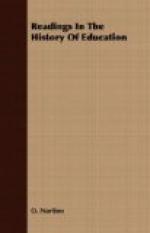The medical learning of western Europe was greatly enlarged during the eleventh and twelfth centuries by the translation into Latin of numerous works by Greek, Arabic, and Jewish physicians. These became the standard text-books of the Faculties or Schools of Medicine. The Greek writers most commonly mentioned in the university lists of studies are Hippocrates (fifth century B.C.) and Galen (second century A.D.). Several of their more important works were first translated—like those of Aristotle—from Arabic versions of the original Greek. Avicenna (c. 980-1037) furnished the most important Arabic contribution. Accounts of these men and their writings may be found in any good encyclopedia. For the program of studies at Paris see D.C. Munro, “Translations and Reprints,” Vol. II, Pt. III. A list of the books used at Montpellier, one of the most important medical schools, is given in Rashdall, Vol. II, Pt. I, p. 123, and Pt. II, p. 780; the list for Oxford, p. 454 f.
(f) Other University Text-books
The foregoing sections indicate the books which furnished the intellectual basis for the rise of universities, and particularly the basis for their division into Faculties. They do not indicate by any means the whole list of books used in the universities between 1200 and 1500; nor is it possible here to give such a list. Two facts only are to be noted concerning them: First, a considerable number of books already well known in the twelfth century were used in addition to those mentioned above. Among these may be mentioned the Latin grammars of Donatus (fl. 350 A.D.) and Priscian (fl. 500 A.D.), treatises by Boethius (c. 475-525) on Rhetoric, Logic, Arithmetic, and Music, and his translations of various portions of the Organon of Aristotle, and of the Iagoge, or Introduction to the Categories of Aristotle, by Porphyry (c. 233-306). The Geometry of Euclid (fl. 300 B.C.) was translated about 1120 by Adelard of Bath, and the Astronomy (Almagest) of Ptolemy (second century A.D.) was pharaphrased from the Arabic by Gerard of Cremona toward the close of the twelfth century, under the title Theorica Planetarum.
Second, during the whole period under discussion there was an active production of new text-books on the established subjects, some of which were widely used in the universities. Among the grammars was the Doctrinale of Alexander da Villa Dei, written in 1199. This rhyming grammar was enormously popular, and continued to be so, well into the sixteenth century. The Grecismus and Labyrinthus of Eberhard of Bethune (early thirteenth century), also grammars in rhyme, were widely used. Logical treatises often mentioned in university programs of study were De Sex Principiis (On the Six Principles), written about 1150 by Gilbert de la Porree, a teacher of John of Salisbury; and the Summulae of Petrus Hispanus (thirteenth century). In the thirteenth




